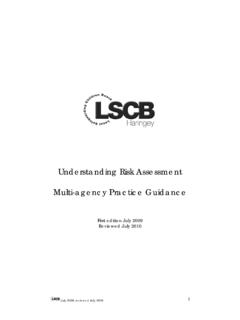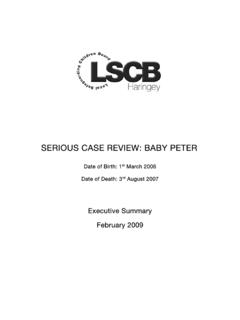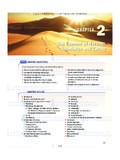Transcription of HARINGEY LOCAL SAFEGUARDING CHILDREN …
1 HARINGEY LOCAL SAFEGUARDING CHILDREN board RISK management STRATEGY 1. Introduction This strategy addresses the way in which risk is managed by CHILDREN s agencies within HARINGEY . All assessments of CHILDREN s circumstances are assessments of risks they may conclude that there are no risks to address but they should all assess risk. It is right therefore that a coherent approach is set out and endorsed by the organisation and its partners through the LSCB. This strategy starts from the understanding that risks to CHILDREN exist the job of social care (as the lead agency in statutory risk assessments) and partners is to understand and manage that risk effectively.
2 Risk management does not mean risk taking, which exposes CHILDREN to avoidable injury and harm, nor does it mean risk aversion which can lead to an overly interventionist role in the lives of CHILDREN and their families. Risk management means understanding and analysing the risks CHILDREN face and actively managing them to reduce their impact. It means balancing the risk of non-intervention with the risks associated with intervention. The strategy takes as its underlying principle that it is the role of CHILDREN s agencies to enable CHILDREN to live safely at home in their families wherever possible.
3 Therefore, input into families has to focus on identifying, reducing and managing risk to ensure CHILDREN s safety at home. Where that is not possible, or cannot be made possible in a timeframe consistent with the needs of the child, then intervention needs to be purposeful and focussed. Child protection work is essentially an inter-agency function CHILDREN can only be kept safe through agencies working together effectively and efficiently. The Police and various aspects of health provision share that responsibility with CHILDREN s social care. CHILDREN s social care work is devoted to the management of risk; it is a risk management agency.
4 The Metropolitan Police Child Abuse Investigation Command has developed an approach to risk management known as CRAM the CHILDREN s Risk LSCB July 2010 1 Assessment Matrix. The approach set out in this strategy is entirely consistent with CRAM but equally can be applied to those cases where social care remains the single agency involved. 2. Some Dangers in Managing Risk Much has been written about some classic difficulties in child protection work. Largely they are a consequence of risk not being properly understood and managed.
5 For example: Rule of optimism comes as a result of not properly understanding the risks CHILDREN face and results in leaving CHILDREN in places of danger; Rule of hopelessness a sense that no change can be arrived at and staff give up seeking positive changes. This can result in avoidable interventions or CHILDREN left at risk; Incident-led responses seeing only the presenting issue and not the history or context; Assessment Paralysis/A focus on the adults staff aligning themselves with and seeking to assist adults and losing sight of the child. An accurate assessment of risk well managed ensures the needs of CHILDREN are kept at the heart of the work; Assessment Distortion a position adopted by a multi-agency network that is led by one agency to such an extent that other and potentially opposing views are not voiced or heard; Inter-Agency communication failures key information not being shared either at all or in a timely manner; Procedural Compliance a view in child protection work that risk cannot only be managed but be eliminated through an increasing adherence to and reliance upon procedures.
6 Inherent within this approach is a focus on maximising compliance from staff and from systems such that all risk is effectively managed out of the system. None of these positions are balanced and balance is essential to the effective management of risk. A degree of optimism is important in working with vulnerable families, so is a degree of scepticism; engaging with adults is absolutely unavoidable and an adherence to set procedures is necessary to avoid an anarchic response. The views of all agencies, particularly where they diverge, should be heard and balanced to arrive at an informed position.
7 The key is that these, and other considerations, are well balanced and that the development of assessments, the gathering of information and the exploration of new hypotheses allows for the respective balance between these themes to be managed and amended as required. LSCB July 2010 2 This balanced position is often a difficult and challenging one to arrive at - it is a matter of fact that SAFEGUARDING CHILDREN is a complex and multi-faceted task. It is managing this complexity and practitioners being able to adopt this balanced position which is what is meant by authoritative practice.
8 One way authoritative practice can be evidenced is by social workers and fellow professionals attaining and holding that balanced position and being able to shift that position to reflect changing circumstances for CHILDREN there will be times when an optimistic and supportive position should take precedence and others when a more explicit scepticism and mistrusting approach is warranted. Authoritative practice means that professionals are aware of their professional power, use it judiciously and that they also interact with clients and other professionals with sensitivity, empathy, willingness to listen and negotiate and to engage in partnerships.
9 They respect client autonomy and dignity while recognising their primary responsibility is the protection of CHILDREN from harm and the promotion of their well-being. adapted from Jane Gilgun It is this ability to shift perspective whilst hanging onto the centrality of the safety of the child that is a key element in authoritative practice and what is meant by the phrase - an assessment is an on-going process not a one-off event. (Key message from HARINGEY Serious Case Review, 2009). 3. Assessing Risk The challenge is not in finding the answer it s in identifying the next question Eileen Munro, in her work, Effective Child Protection 1 states that in order to manage risk, there is a need to identify: (i) What has been happening (ii) What is happening now (iii) What might happen (iv) How likely it is (v) How serious it would be (vi) A combination of seriousness and likelihood leading to an overall judgement of risk It is self evident that risk can only be properly managed if it is properly understood.
10 That means assessments must be focussed on identifying and quantifying risk Section 47 CHILDREN Act 1989 sets out the circumstances 1 Munro, Eileen (2008) Effective child protection. Sage Publications, Los Angeles, USA. ISBN 9781412946957 LSCB July 2010 3 under which an investigation into specific incidents or concerns should take place, but all assessments are assessments of risks . Assessment is the purposeful gathering and analysis of available information.









